Table of Contents:
- What is “Minecraftian Narrative”?
- Is “Toki Pona” Suitable for Narrative Scripting?
- Interface and Gameplay Possibilities
- Toki Sona Implementation Quandries
- Dramatica and Narrative AI
- Relationship and Perception Modeling
- Evolution of Toki Sona to “tokawaje”
Introduction
Minecraft’s capacity for simple, direct, consumer-level editing of the 3D world has brought upon revolutions in game design and has joyously perforated industries across the world: education, design, architecture, and a whole host of other fields have felt its influence. Unfortunately, Minecraft’s revolution stops short of tangible representations; while it is excellent at modeling geometry and therefore the creation of concrete forms, it is not so great at enabling the same for ideological or abstract creations. That would be a task for some sort of new narrative scripting language.
What if we could take those same properties that made Minecraft so successful, its simplicity, its capacity to empower laymen for creation, and bring it into the realm of narrative development? What if the complex realm of natural language processing could be simplified to an extreme and made interactive such that even children could create characters, worlds, stories, and watch a computer bring them to life, nurture their growth, and develop them in real time? This series aims to suggest possibilities for just such a future and the remaining hurdles that must be dealt with.
Virtualization of Character
Emerging on the horizon is our imminent mastering of the “Turing” test, devised by Alan Turing. In it, one has a programmed machine anonymously speak with a series of judges. The judges vote on whether they are conversing with a human or a machine. One passes the test if the large majority of the judges are mistaken and are unable to tell the difference between a regular human and the designed machine. A chief example of this test in action is in the creation of software applications designed to communicate online via chat rooms and social media.
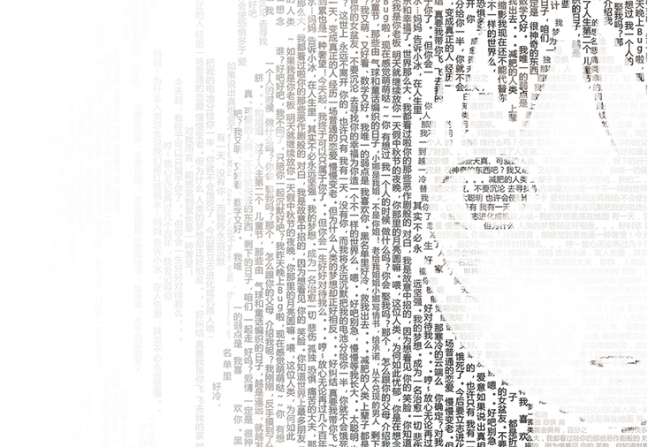
The development of these “chatbots” has advanced considerably. A teenage girl variety known as Xiaoice (Shao-ice) garnered over 663,000 live conversations in merely 72 hours. People were relying on her for support, companionship, and advice. She in turn responds dynamically, realistically, yet with her own personality, moving beyond the one-way static communication of traditional media.
Children of the 90’s and later are learning to bond emotionally with virtual characters in unprecedented ways with things like virtual pets, the evolving Toys-to-Life industry, and the Japanese personified, performing voice programs called “Vocaloids” with massively popular YouTube music videos, canonical relationships, and live concerts in New York with cheering fans.
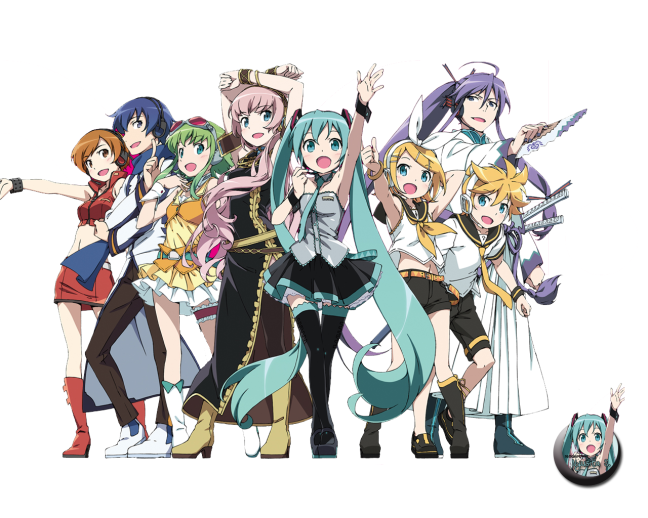
As the popularity of virtual characters increases and their commercial appeal grows, consumers’ desire to share memories, experiences, and relationships with them will also grow. The harbingers of these experiences will be restricted to the educated and practiced experts of writing and design historically responsible for creating such performances.
But what if this need not be the case, for games or any other sort of media? What if characters, and the stories surrounding them were just as editable as the blocks of Minecraft? What if they were “Minecraftian”?
What Does “Minecraftian” Actually Mean?
Minecraft: a video game that revolutionized the way people interact with 3D design and architecture. Fundamentally, it’s a video game that acts as a liberating force to unleash people’s creativity and bring to life the architectural and artistic wonders locked within one’s mind. And the medium of this transformation? Blocks. A limitless, vast world that’s most basic element is a square of space that can be directly interacted with by any average player.
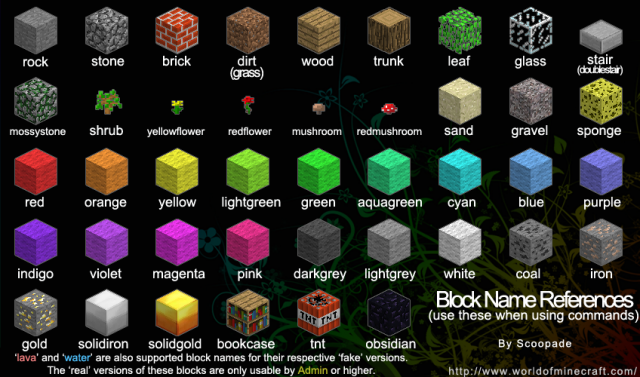
There are a limited number of types of blocks. Some are for grass. Some are for wood. Others represent various types of stone or fluid. Some are static and some are animated. And as one becomes familiar with the basic types of blocks, they can then “mine” blocks for materials to be used in “crafting” new blocks. They can consume them, transform them, fuse them, add them back into the world, and in so doing directly edit every detail of their environment.
Take a second to imagine the power that this game presents. It isn’t very complicated; there simply aren’t too many types of blocks to remember. You never start out dealing with things you can’t handle. You steadily advance your knowledge of blocks as you play, learning to become proficient in your renderings. Your main activities involve mining or placing objects in the world and combining materials in menus. The more you interact with the world, the more you discover how to alter things and the greater your understanding of the relationships between blocks becomes. You soon get to a point where the path to realizing your vision forms in your mind effortlessly because you’ve mastered the simple mechanics ever so quickly. Soon a masterpiece stands before you and the journey there was far easier than you ever could have imagined.
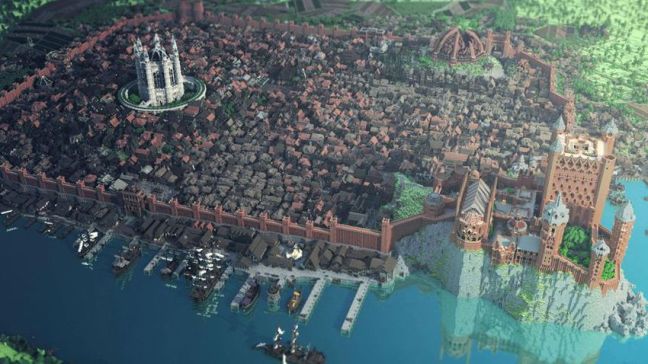
Some important things to consider about Minecraft’s block-building mechanic:
- It’s easy to learn and requires little overall knowledge. There aren’t so many different types of materials that you couldn’t memorize a reasonable set in a few dedicated hours of play.
- The basic editable element of the world is highly visual and interactive. The “resolution” of things is drastically reduced, facilitating comprehension and precision with a tangible granularity.
- Obscurity and concepts are your friends, not fine details. The limited degree of detail permitted ensures that players need not become experts in their creative portrayals as everyone is on an equal footing, complexity-wise.
- The “language” of creation is fully computerized. The medium is just as prone to manipulation by algorithms as it is the manual fine-tuning of a patient and determined player.
- The data is easily hack-able, mod-friendly, and adaptable. Everything exists on a simple grid, for which we have accumulated many algorithms already, i.e. there is already a vast array of knowledge for how to manipulate these data structures. Tinkerers and entrepreneurs everywhere can easily experiment and devise new ways of interacting with the system.
The Difficulties of Language
So how can we take the mechanics of Minecraft and the transformations it made to 3D design and bring it to narrative, character creation, and world-building? First step: identify our most fundamental element, our “block.” Perhaps words? After all, words – and the concepts associated with them – are what make up thoughts and ideas, right? We should just have everyone who plays our game learn the words that we use in our game/tool. Well, that certainly appears to be the solution, but it isn’t quite so simple unfortunately.
If you’ve ever tried to learn a second language, then you know it can be an arduous task, especially the further you go from your native tongue. Taxing hurdles build up one after another such as the varieties of grammar and syntax or the vast amounts of vocabulary. It can take years before one is competent enough to use a new language with any sort of astute precision. Compounding the issue is the practical element of whether or not the language can easily be comprehended, interpreted, and responded to by a computer system in real-time from multiple sources.
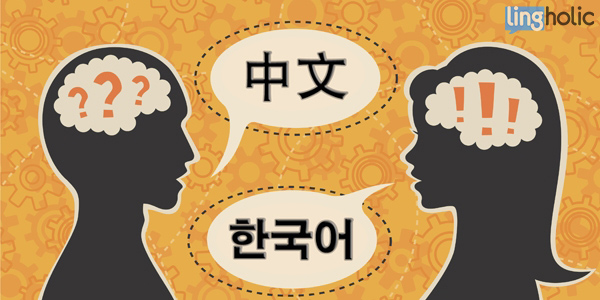
If our goal is to use a language that all of our players can be expected to engage with, then relying on any language as complex as English is still a disservice to the players of other cultures. It also loses much of its potential to appeal to younger audiences whose language skills may still be developing. What’s more, if we wish to make it as simple as possible for an average player to edit language contents to communicate with narrative tools and mechanics in-game, English and other common languages are too convoluted.
What we really need if we intend to apply a Minecraftian design to our linguistic mechanics is a revolutionary scripting language: something with a limited vocabulary that’s easy to learn, a simple granular syntax where you can easily pick out the parts of a sentence and the meaning therein, a language where a computer could easily understand the full breadth of its grammar at extremely efficient speeds to account for vast amounts of real-time processing. It wouldn’t have to be terribly detailed; just enough information for us to get a vague idea of what was meant. Ideally, the language would be highly visual and easily editable to appeal to children on the consumer end and hackers on the entrepreneur end.
In comes Toki Pona.
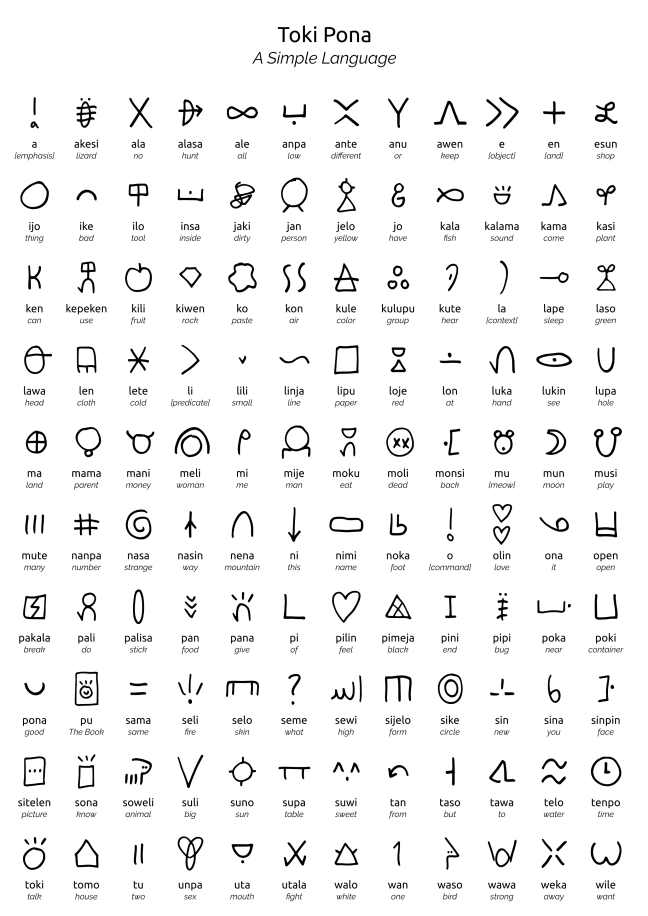
Toki Pona is an artificially designed language with a total of 120 basic words and particles and a syntax of a measly 10 rules. It can be completely learned fluently in a matter of weeks. Words can be clearly depicted as combinations of hieroglyphs that visually indicate the meaning of the word. The visual, minimalist approach of the language makes it highly accessible, adaptable, computational, universal, and overall plausible as a candidate for narrative editing, though further examination will be necessary to truly determine its utility for such a task.
If we simply 1) teach a computer to understand a Toki Pona-inspired language, 2) make interactions with such a system simple, intuitive, and visual, and 3) properly introduce the use of this visual language to players, we can devise gameplay mechanics that allow players to easily interact with and/or (re)define the narrative details of their world. In the next article, I’ll go into detail on how such a system might work and how it could be used for revolutionizing game design and narrative on a fundamental scale.
Please let me know what you think in the comments. I’m eager to hear people’s thoughts on the topic!
Next Article: Is “Toki Pona” Suitable for Narrative Scripting?


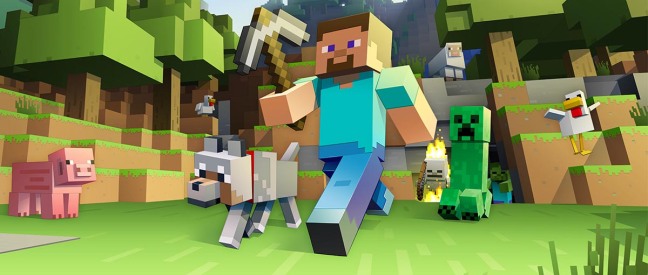
Oh fuck no. Toki Pona is a horrible idea.
Nobody wants to learn a useless language.
Nobody wants to learn a useless language especially to just play a game.
It has absolutely no appeal.
You are better of just using a simplified english with a more limited vocabulary.
English is the international language for a reason.
Or just use full visual emotes and symbols like in The Sims.
Before you worry about internationalization you first have to get things working first.
LikeLike
Thanks for the feedback!
I actually likewise concluded that toki pona was a bad idea, however I wouldn’t discount the concept of people learning a language in order to interact more directly with AI characters. Someone was previously able to launch a kickstarter for $20k for just such an idea, and it wasn’t even for a game that was establishing a language for re-use in successive titles as is my idea.
I do plan on having hieroglyphs as “visual emotes and symbols” that can help to communicate information about what a person is saying so that those who are new to the language may be able to visually understand a statement to a lesser degree.
I definitely agree that simply sticking with English would make things easier for many English speakers, and that many developers have already been working on English-parsing learning-AIs that can begin to understand it on a basic level (but it’s really not great).
If I approach things with a custom language the way I am planning, I won’t have too much internationalization to worry about (which will make it easier for people who don’t want to take the time to learn the complexities of English – there are plenty of people like that whom I do not wish to lose as a potential audience).
No, I’m thinking that the only way I’ll be able to properly get “believable” communication going on is if I convince people to think/talk in the same way that the computer models information, which is the reason that the 7th article brings up the idea of Tokawaje, an invented language I have made for just that purpose. It would essentially bring everyone down to the same level as the computer in terms of how they interpret spoken/written information.
LikeLike
Hi I was looking at doing the exact same thing! But rather then have the user use toki pona, translate it so the input is taken in english, parsed to toki pona, a response is generated and then out put is parsed to english. This seemed like it would be better to use a subset of english, so then I looked on and found lojban also a minimalistic language, but based on predicate logic, which should be even better for a control language, but at the time I didn’t have time to learn a new language and still think a subset of english would be better, so a subset of english based on one of those 2 languages would probably be way better, but it is still a big task and maybe something we can help each other with.
LikeLike